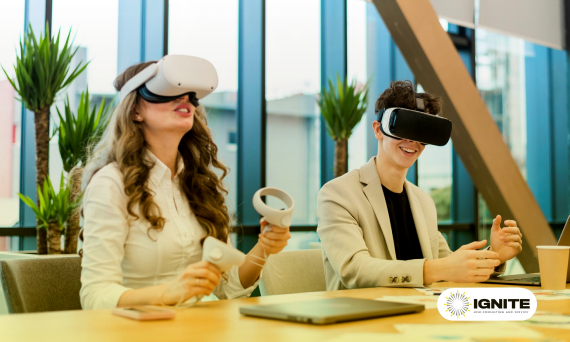
In today's fast-paced, ever-evolving business landscape, companies are constantly seeking innovative ways to train and develop their employees. Traditional training methods, such as classroom lectures and PowerPoint presentations, are becoming less effective in engaging and retaining employees' attention. Enter Virtual Reality (VR) technology – a game-changer in the world of employee training and development.
Virtual Reality is a computer-generated simulation of a three-dimensional environment that can be interacted with in a seemingly real or physical way using specialized equipment, such as a headset with a screen or gloves fitted with sensors. VR technology immerses users in a fully interactive, 360-degree environment, allowing them to experience and interact with virtual scenarios as if they were real.

One of the most significant advantages of using VR in employee training is the immersive learning experience it provides. By placing employees in a virtual environment that mimics real-life situations, they can practice and hone their skills in a safe, controlled setting. This hands-on approach to learning is far more engaging and effective than traditional classroom-style training.
Studies have shown that employees retain information better when they are actively engaged in the learning process. VR training allows employees to interact with the content, making it more memorable and easier to recall when needed. In fact, research conducted by the National Training Laboratory found that learners retain up to 75% of the information they learn through VR training, compared to just 5-10% through traditional lectures.
Implementing VR training can be a cost-effective solution for companies in the long run. While the initial investment in VR equipment and software may seem steep, it eliminates the need for expensive travel, accommodations, and venue rentals associated with traditional off-site training. Additionally, VR training is highly scalable, allowing companies to train large numbers of employees simultaneously, regardless of their location.
In industries such as healthcare, manufacturing, and construction, where on-the-job training can be dangerous, VR provides a safe alternative. Employees can practice high-risk procedures and scenarios in a virtual environment without the fear of causing harm to themselves or others. This not only reduces the risk of accidents but also allows employees to learn from their mistakes without real-world consequences.
VR training can be customized to meet the specific needs of a company and its employees. Training modules can be designed to address unique challenges, scenarios, and skill sets relevant to a particular industry or job role. Furthermore, VR training can be easily updated and adapted as business needs change, ensuring that employees are always receiving the most up-to-date information and training.
While VR training offers numerous benefits, there are some challenges and considerations companies must keep in mind when implementing this technology:
The upfront cost of VR equipment and software can be a significant investment for companies, especially smaller businesses with limited budgets. However, as VR technology becomes more widespread, the cost is expected to decrease, making it more accessible to a wider range of companies.
Some employees may experience motion sickness or discomfort when using VR headsets, which can hinder the effectiveness of the training. Additionally, VR technology is still evolving, and there may be limitations to the level of realism and interactivity that can be achieved in certain scenarios.
Integrating VR training into existing training programs may require significant time and effort. Companies must ensure that VR training aligns with their overall training objectives and complements other training methods, such as classroom instruction or e-learning modules.
Some employees may be resistant to using VR technology, either due to a lack of familiarity or a preference for traditional training methods. Companies must effectively communicate the benefits of VR training and provide adequate support and guidance to ensure employee buy-in and engagement.

As VR technology continues to advance, its potential applications in employee training are limitless. In the future, we can expect to see more sophisticated VR simulations that incorporate haptic feedback, allowing employees to physically feel and interact with virtual objects. Additionally, the integration of Artificial Intelligence (AI) into VR training could enable personalized learning experiences that adapt to each employee's individual needs and learning style.
Furthermore, the ongoing COVID-19 pandemic has accelerated the adoption of remote work and virtual collaboration tools. VR technology could play a significant role in facilitating remote training and team-building activities, allowing employees to connect and learn together in a virtual environment, regardless of their physical location.
Virtual Reality is revolutionizing the way companies approach employee training and development. By providing an immersive, engaging, and safe learning environment, VR technology enables employees to acquire new skills and knowledge more effectively than ever before. As more companies recognize the benefits of VR training, we can expect to see widespread adoption across various industries in the coming years.
However, implementing VR training is not without its challenges, and companies must carefully consider the initial investment, technical limitations, integration with existing programs, and potential employee resistance. By addressing these challenges head-on and communicating the benefits of VR training to employees, companies can successfully leverage this innovative technology to create a highly skilled, confident, and adaptable workforce.
As the business world continues to evolve at an unprecedented pace, companies that embrace cutting-edge technologies like Virtual Reality will be well-positioned to stay ahead of the curve and thrive in an increasingly competitive landscape. The future of employee training is here, and it's an exciting time to be a part of this transformative journey.


